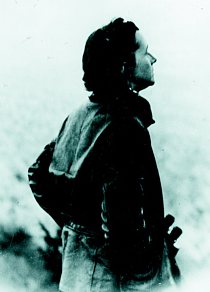 |
| NHC Home |
|
Rachel Carson and the Awakening of Environmental Consciousness Linda Lear, George Washington University ©Linda Lear ©National Humanities Center |
|
(part 6 of 6)
SCHOLARS DEBATE
Rachel Carson has long been recognized by historians as a pivotal figure in the modern environmental movement. Excerpts of her writing were first published by her editor and friend Paul Brooks who appreciated her achievements as a prose writer but saw her as a tragic and limited figure. Carson's biographer, Linda Lear (Rachel Carson: Witness for Nature [1997]), finds Carson an activist and woman of fulfillment, not a victim. She consciously used her literary gift and her political understanding to challenge the direction of science and technology and force a transformation of environmental consciousness. The emotional cost of Carson's crusade during a time when she was dying of breast cancer is documented by her correspondence with a friend, Dorothy Freeman, a neighbor in Maine.
Carson at Hawk Mountain, Pennsylvania, c. 1947
Some historians argue that Carson took the middle ground in Silent Spring and did not go far enough in challenging the power of big business and the scientific establishment. Yaakov Garb presents the best argument that Carson's moderation had costs which underlie the pesticide triumph of today. He is joined by critics who point to her defense of the outmoded concept of a balance of nature as contributing to the political softness of her attack. These critics chide Carson for not naming names of chemical companies who were irresponsible polluters and therefore failing to give a full critique of the process by which science invents and then assesses its own results.
Rhetoricians regard Silent Spring as one of the finest examples of apocalyptic literature and credit Carson with writing a book that established the policy agenda of citizen participation for the second half of the twentieth century. To sample this kind of analysis see Craig Waddell, ed., And No Birds Sing (2000).
When scholars and journalists debate the shortcomings and successes of the Green Revolution, Carson's name is always mentioned. She is either hero or villain depending upon the current fortunes of environmental politics. Those who believe
that she set in motion an idealistic movement that values species over jobs and human livelihood deplore the millions of dollars spent by state and federal agencies to clean up pollution and attack polluters. Gregg Easterbrook is among those who find Carson an early scaremonger who did more harm than good. Other recent chroniclers criticize Carson for failing to include a more biocentric approach to her critique of pesticides. The same commentators lament her failure to include the rights of other nonhuman species, and for neglecting the issues of social justice and equity in the decisions of who sprays and who gets sprayed. But historians such as Robert Gottlieb in Forcing the Spring (1993) applaud Carson for placing the very nature of the urban and industrial order on environmentalists' agenda and fearlessly confronting the issue of the destruction of nature as a debate over the quality of life.
Idle oystermen meet with government officials during fishing ban due to contaminated waters, Louisiana, 1973
EPA researchers collect oysters to check for pesticide residue, Florida, 1972
Four decades after Carson's revolutionary call to re-evaluate our relationship with the natural world, we are still debating the questions she raised. In arguing that public health and the environment, human and natural, were inseparable, Carson insisted that the role of the expert had to be limited by democratic access and public debate about the risks of hazardous technologies. A reading of your local newspaper is bound to produce examples of the complexity of the debate over the role of science and the rights of the citizen to be assured of a healthy environment. It's a great way to access Rachel Carson's ultimate legacy.
EPA looks into chemicals left at Pataskala truck terminal
PATASKALA, Ohio -- When the Matlack trucking company vacated its terminal and washing facility here in 1987, it left behind some hazardous chemicals, including cleaning solvents.
Those chemicals -- which have been found in former holding ponds, the soil and groundwater at the 10- acre site off Mill Street -- are now the focus of an Ohio Environmental Protection Agency investigation.The Columbus [Ohio] Dispatch, March 24, 2001
Mike Lafferty, Staff Reporter
full text
Links to Online Resources
Illustration Credits
Works Cited
Linda Lear received her doctorate from The George Washington University and is Research Professor of Environmental History at The George Washington University. She held fellowships from the Beinecke Rare Book Library at Yale University and from the Smithsonian Institution where she has also been a Research Collaborator. Her published works include Harold L. Ickes: The Aggressive Progressive, 1874-1933 (1981), Rachel Carson: Witness for Nature (1997), Lost Woods: The Discovered Writing of Rachel Carson (1998), "Searching for Rachel Carson" in Craig Waddell, ed., And No Birds Sing (2000), the introductions to the 1999 editions of Rachel Carson's The Sense of Wonder and The Edge of the Sea, and the Afterword to the 1999 edition of Carson's Silent Spring. She has been a consultant to various museum exhibitions and television documentaries on Rachel Carson and is the site founder and manager of www.rachelcarson.org.
Address comments or questions to Professor Lear through TeacherServe "Comments and Questions."
| "Wilderness and American Identity" Essays |
| The Puritan Origins of the American Wilderness Movement | The Challenge of the Arid West | Rachel Carson and the Awakening of Environmental Consciousness | Essay-Related Links |
TeacherServe Home Page
National Humanities Center
7 Alexander Drive, P.O. Box 12256
Research Triangle Park, North Carolina 27709
Phone: (919) 549-0661 Fax: (919) 990-8535
Revised: June 2002
nationalhumanitiescenter.org


